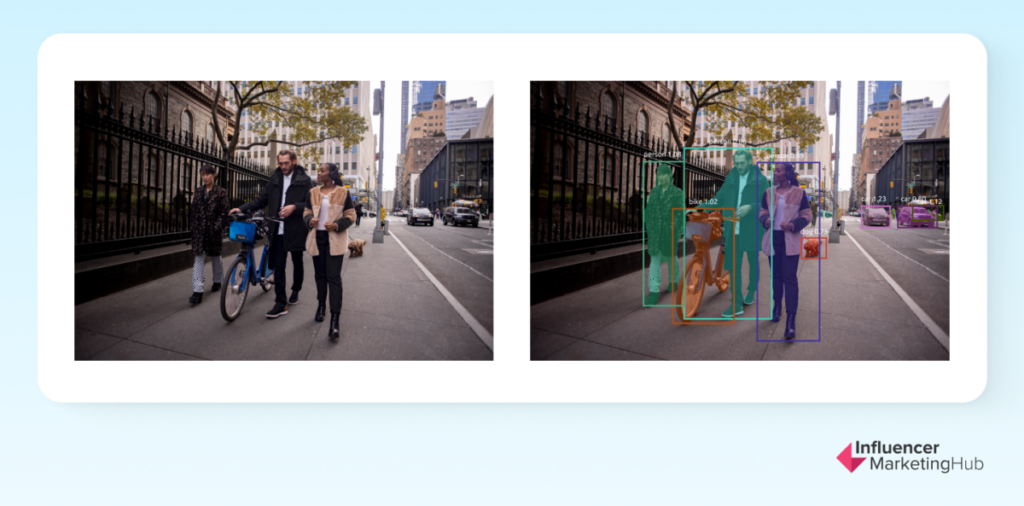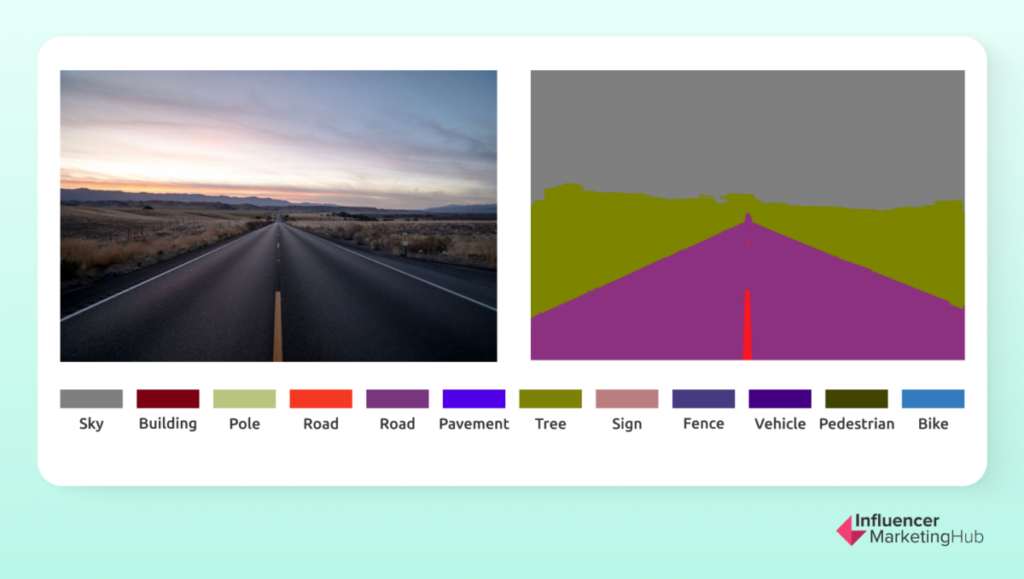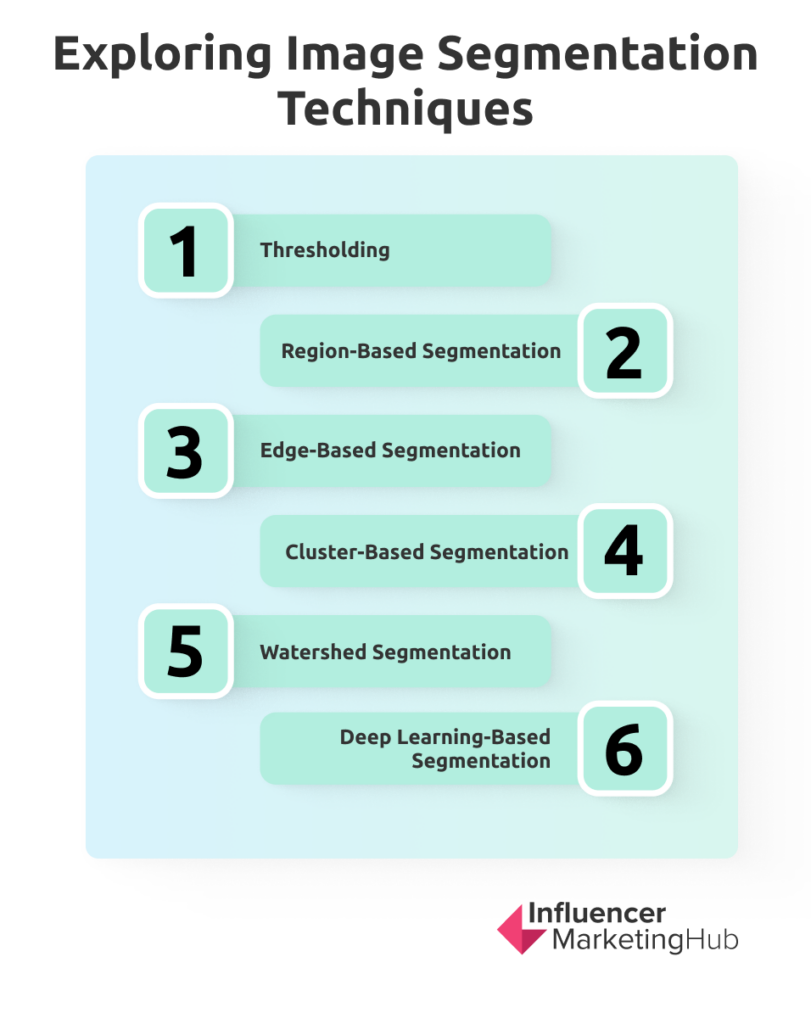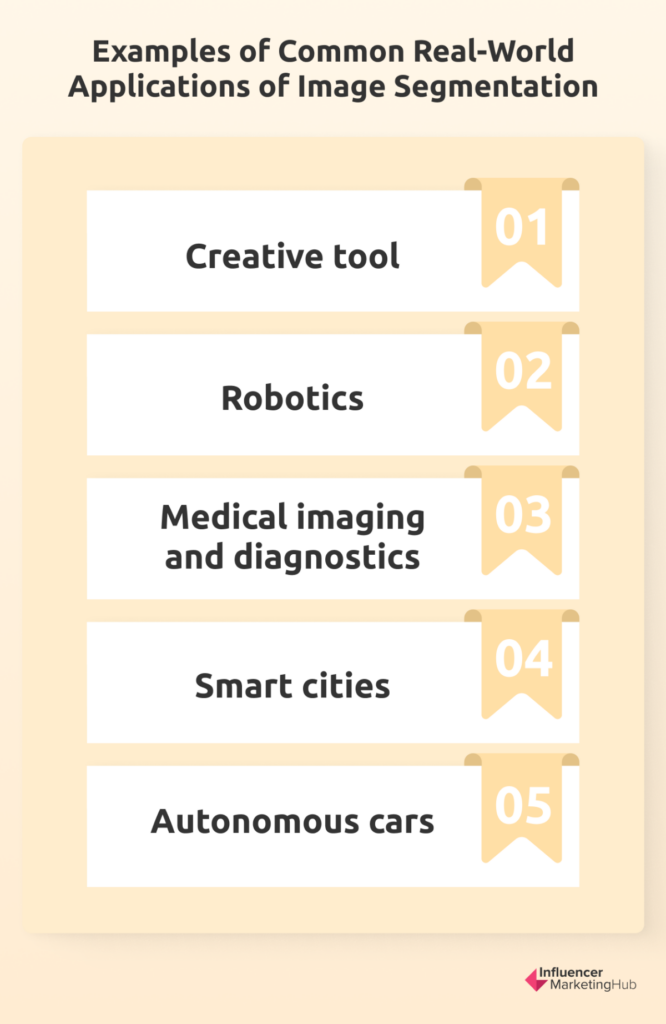When trying to cross a street, you typically look left and right, assess the traffic, and then decide. In just milliseconds, your brain can identify approaching vehicles and the surrounding environment. Is this something machines can do? Until recently, the resounding answer was ‘no.’ However, advancements in computer vision have transformed this landscape.
Just recently, XXII, a computer vision company that uses AI, has raised €22M in a Series A funding round. Now computer vision models can detect objects in images, discern their shapes, and more.
At any moment, you are surrounded by countless objects, and your eyes can determine their boundaries in a 3D space. Computer vision has progressed to not only detect and label objects in a given image but also accurately outline their entire form, regardless of their unique shapes, all thanks to image segmentation. As the name suggests, AI image segmentation involves dividing an image into multiple segments. In this process, each pixel in the image is associated with a specific object type. This association allows for a considerable increase in accuracy and precision in image annotation tasks, which can be applied to cutting-edge technological advancements.
As cameras and other devices need to perceive and interpret their surroundings more and more, image segmentation has become an essential technique for teaching these machines to comprehend the world around them.
An Overview of Image Segmentation
Image segmentation is a crucial aspect of computer vision research, encompassing both image processing algorithms and learning-based methods. As a sub-domain of digital image processing, it aims to categorize related areas or segments within an image by assigning class labels, often based on features such as color or texture. This technique, also referred to as “pixel-level classification,” involves dividing images or video frames into multiple segments or objects.

Object detection is an essential use of image segmentation. While image recognition assigns labels to an entire image, object detection locates objects within bounding boxes. Image segmentation provides a more detailed analysis of what's inside an image. First, the image is segmented to identify objects of interest. Next, the object detector can focus on the segmented area, increasing accuracy and speeding up the process. Data sets, either manually created or open-source, are used to train the system to effectively classify and recognize visuals. This makes image segmentation a crucial tool in machine learning.
Over the past four decades, numerous segmentation techniques have been developed, ranging from traditional computer vision algorithms and MATLAB image segmentation to advanced deep learning methods. With the emergence of Deep Neural Networks (DNN), image segmentation applications have progressed significantly.
A Quick Look at the Image Segmentation Process
Image segmentation is a process that takes image inputs and produces a segmented output. The output is made of a mask or a grid with different parts showing which object category, for example, each pixel in the image belongs to. There are several ways to do image segmentation using special characteristics or properties of the image. These properties are the foundation of traditional image segmentation techniques, which include grouping methods.
Colors and contrasts can be used as tools to help machines understand and process images. A green screen is a good example because it provides a plain background that can be easily replaced later on. When there is a big difference between the brightness of an object and its background, image segmentation algorithms can easily recognize the edges and boundaries of the object.
Standard image segmentation methods based on these rules can be easy to use but might require significant tweaking for custom scenarios. They may also not be accurate enough for intricate pictures. To improve their precision and flexibility, modern techniques rely on machine learning and deep learning. ML-based image segmentation teaches the system to better identify critical features, and DNN algorithms are highly effective for this type of image segmentation.
Image segmentation may be done using a range of models for neural networks and algorithms. They usually have three main components:
- Encoder
- Decoder
- Skip connections
The encoder and decoder are two important parts of image segmentation. The encoder extracts image data using deep and narrow filters and is often previously trained on tasks like image recognition to help with segmentation. Meanwhile, the decoder turns the encoder's output into a mask that matches the original image. To improve accuracy, skip connections are used, which help the model recognize different feature sizes.
In computer vision, many image segmentation models use a combination of an encoder and a decoder, unlike classifiers that only have the former. The encoder creates a hidden representation of the input, and the decoder uses this to make maps that show the location of each object in the image.

A Guide to Different Image Segmentation Types
There are multiple methods for segmenting a picture. However, the tasks can be split into two primary categories and one new variety.

1. Semantic Segmentation
Semantic segmentation is a computer vision technique that assigns a class label to each pixel in an image based on semantic meaning. This enables the identification and classification of various regions within an image. For instance, it can identify buildings, roads, parks, and water bodies in an aerial photograph of a city, generating distinct segments for each type. This allows for better analysis and understanding of the terrain.
However, semantic segmentation can be vague wherein multiple instances are grouped into the same category, such as identifying an entire crowd on a busy street as "humans." As a result, semantic segmentation does not provide comprehensive information about complex images.
2. Instance Segmentation
Instance segmentation is a technique that classifies pixels according to individual occurrences of an item rather than by object classes. These algorithms focus on separating comparable or intersecting regions based on object boundaries without determining the class each region belongs to.
For instance, instance segmentation can distinguish between white blood cells, red blood cells, and cancer cells in a blood sample. This approach helps in understanding object distribution and interactions within complex scenes.

3. Panoptic Segmentation
Panoptic segmentation is an advanced computer vision method that combines semantic and instance segmentation to classify every pixel in an image while differentiating between objects of the same type. It aims to provide a complete understanding of an image by classifying every pixel while also distinguishing between individual instances of the same class. For example, in a picture of a busy playground, panoptic segmentation would classify grass, swings, benches, and children while also identifying and separating each person even if they are part of a group. As a result, you can get a detailed and coherent representation of the entire scene.
Panoptic segmentation is critical in applications that require large amounts of data, such as self-driving cars, which use real-time image feeds and panoptic segmentation algorithms to navigate and make informed decisions on the road.
A Study of Various Image Segmentation Techniques
Numerous techniques exist for performing image segmentation, ranging from traditional to more unconventional approaches. Each method comes with its own set of strengths and weaknesses but ultimately offers a distinct way of producing the final result for an image or video.

1. Thresholding
Thresholding is a technique used to separate an image into different categories based on pixel intensity levels. By selecting a threshold value, this technique transforms a grayscale image into a binary image where pixels with intensity values greater than the threshold are classified as 1 and those less than the threshold are classified as 0.
For instance, thresholding can be used to isolate text from a document's background. By selecting a threshold value between the intensity of the text and the backdrop, the text can be easily separated from the background, making it easier to analyze or apply text recognition algorithms.
2. Region-Based Segmentation
Region-based dissection entails dividing an image into different regions based on similarities in properties such as color or texture. Each area is identified by an algorithm using a seed point and can be expanded or combined with other regions. The algorithm classifies neighboring pixels with commonalities into a single category. The process continues until the entire image is segmented.
For instance, a region-based segmentation algorithm can be used in a medical image to differentiate between organs such as the liver, kidneys, and heart. It can also be used in natural scene images, like a landscape photo, to separate the sky from the ground.
3. Edge-Based Segmentation
Edge-based segmentation is an image processing technique that separates the edges of objects in an image. This method uses edge detection algorithms to detect sharp changes in color or intensity between adjacent pixels, which indicate object boundaries.
For example, an edge-based segmentation algorithm can be used to detect the edges of buildings in an urban landscape photo. By identifying the edges, the algorithm can separate the buildings from the background and create a more detailed image with clear object boundaries.
To detect edges, specific filters are used that compute image gradients in the x and y coordinates. The Canny edge detection algorithm is a common technique used for edge detection.

4. Cluster-Based Segmentation
Cluster-based segmentation is an image processing technique that groups pixels based on similar properties such as color, intensity, or texture. Clustering algorithms aid in the identification of obscure data in images by separating data items and grouping similar elements into clusters. This technique is commonly used in modern image segmentation methods.
Clustering systems like the K-means clustering algorithm are unsupervised and classify pixels with similar features into the same segment, producing reasonably good segments in a short amount of time.
For instance, in a fruit basket image, cluster-based segmentation can group similar pixels into clusters that correspond to different types of fruit based on color and texture. By separating these clusters, it becomes easier to count the number of fruits of each type or analyze the overall color distribution of the fruits.
5. Watershed Segmentation
Watershed segmentation is an image processing method that sees pictures as topographic maps. The pixel brightness in the image represents the terrain's height. The algorithm analyzes images like a topographic map and groups pixels of the same gray value. It identifies ridge and basin lines, separating images into different sections based on pixel height. This technique is useful in medical image processing, such as in MRI scans, as it can help detect differences in lighter and darker areas for diagnosis.
6. Deep Learning-Based Segmentation
Deep learning techniques have transformed image segmentation by introducing highly accurate and efficient methods. Convolutional Neural Networks (CNNs) have played a significant role in this transformation. CNNs apply a hierarchical approach to image processing, using multiple layers of filters to extract high-level features from the input image. This technique has led to significant advancements in image segmentation, enabling the accurate detection of various objects in an image.
An Exploration of the Applications and Use Cases of Image Segmentation
Image segmentation finds use in various domains like robotics, diagnostic imaging, autonomous vehicles, and smart surveillance analytics. Below are some examples of the most common real-world applications of image segmentation.

1. Creative tool
There are many ways in which image segmentation can help create unique and innovative content. If you need a photo or video editing tool, you can use image segmentation to enhance your work. By isolating specific regions of an image, you can apply targeted effects like blurring the background to sharpen the foreground or creating stickers from cut-out regions. Image segmentation also lets you develop "try-on" experiences, allowing users to try different products before buying them.
2. Robotics
Image segmentation is useful in various fields, including service, industrial, and agricultural robotics. It helps robots detect objects, understand their surroundings, and interact with objects using visual reference. Robots can perform tasks like recycling object picking, autonomous navigation, and simultaneous localization and mapping. For instance, instance segmentation helps in robotic grasping, while autonomous navigation requires identifying and avoiding obstacles.

3. Medical imaging and diagnostics
Image segmentation can be an effective technique in the initial stages of a diagnostic and treatment pipeline for various conditions that require medical images. Segmentation can help separate important pixels of organs, lesions, and other features that need to be accurately identified. Segmentation plays a vital role in spotting viable malignant features in medical imaging in a speedy and precise manner. Some examples of medical image segmentation include X-ray, CT scan organ segmentation, MRI, ultrasounds, brain tumor segmentation, coronary artery segmentation, digital pathology cells, retina images, and surgical video annotation.
4. Smart cities
Image segmentation is a powerful tool for automating the real-time surveillance of people, traffic, and crime using CCTV cameras. Crimes can be reported more quickly with AI-based surveillance, traffic accidents can be attended to with timely ambulances, and speeding vehicles can be promptly caught and charged. Image segmentation has specific uses such as pedestrian detection, crowd management at events, parking management, license plate detection, road conditioning monitoring, and video surveillance.
5. Autonomous cars
Self-driving cars heavily rely on image segmentation to navigate their environment. Semantic and instance segmentation are used to help these vehicles identify road patterns and other vehicles for a smooth and safe ride. Image segmentation can also be used for detecting car and pedestrian instance segmentation, drivable surfaces, potholes, traffic signs and signals segmentation, and objects left behind by passengers. These applications can improve the safety and efficiency of self-driving cars and make them more viable for the public to use.
Final Thoughts
Image segmentation helps you break down an image into meaningful parts and analyze a scene in greater detail. It helps you identify and comprehend the outlines and shapes of objects in an image. Recent advancements in image and instance segmentation methods have enabled significant progress, allowing the development of real-world applications across various industries. The ability to execute effortlessly what you do with your eyes is a game-changer in AI technology.
Frequently Asked Questions
What is AI image segmentation?
AI image segmentation is a computer vision technique that involves dividing an image into multiple segments or regions, allowing for the identification and classification of objects within the image. Each pixel in the image is assigned to a specific object type, enhancing the accuracy and precision of image analysis tasks.
What are the different types of image segmentation?
The primary types of image segmentation include:
- Semantic Segmentation: Assigns class labels to each pixel based on semantic meaning, grouping similar objects together.
- Instance Segmentation: Differentiates between individual instances of objects, allowing for the identification of separate objects within the same class.
- Panoptic Segmentation: Combines semantic and instance segmentation to classify every pixel while distinguishing between instances of the same class.
How has AI improved image segmentation techniques?
AI, particularly through the use of deep learning and convolutional neural networks, has significantly enhanced image segmentation techniques. These advancements have led to improved accuracy and efficiency in identifying and classifying objects within images, enabling more sophisticated applications across various industries.


